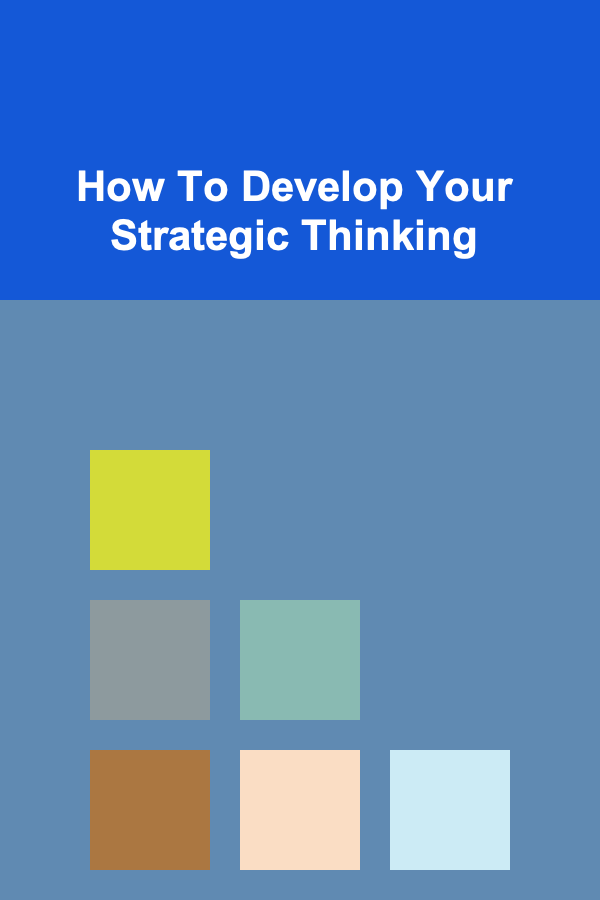
How To Develop Your Strategic Thinking
ebook include PDF & Audio bundle (Micro Guide)
$12.99$9.99
Limited Time Offer! Order within the next:

Strategic thinking is an essential skill in the modern world, whether you are an entrepreneur, a manager, or an employee. It involves the ability to analyze situations, predict potential outcomes, and devise plans that move you closer to your goals. Unlike tactical thinking, which is often short-term and reactive, strategic thinking is more about long-term vision and proactive decision-making. It is about seeing the big picture and finding the best paths to get from where you are to where you want to be.
Developing your strategic thinking is not a quick or simple process; it requires intentional effort, learning, and practice. In this article, we will delve into how you can cultivate this essential skill and apply it effectively to your personal and professional life.
Understand the Importance of Strategic Thinking
Before diving into the methods for developing strategic thinking, it is important to first understand why it matters. The world is becoming increasingly complex, and change is constant. For individuals and organizations to succeed, they must navigate these complexities effectively.
Strategic thinking allows you to anticipate challenges, capitalize on opportunities, and make decisions that align with long-term objectives. It fosters innovation, enables better problem-solving, and helps you to become a visionary leader.
Benefits of Strategic Thinking:
- Proactive Decision-Making: Instead of reacting to situations as they arise, strategic thinking helps you to anticipate future challenges and opportunities, preparing you for what is ahead.
- Improved Problem-Solving: By thinking strategically, you can look at problems from different angles, identify root causes, and develop solutions that address the issue at its core.
- Long-Term Vision: Strategic thinkers don't just focus on immediate results---they keep an eye on the long-term direction and work towards sustainable success.
- Effective Leadership: Whether you're in charge of a team or an organization, strategic thinking helps you make decisions that inspire and guide others toward shared goals.
Embrace a Big Picture Mindset
One of the first steps in developing strategic thinking is cultivating the ability to look at the big picture. This involves seeing beyond the immediate tasks and understanding how they fit into a broader context.
Ask Yourself the Right Questions:
- Where do I want to be in the next 5, 10, or 20 years? Having a clear vision of your future will guide your strategic decisions.
- What are the larger trends in my industry or field? Keeping track of industry shifts, technological advancements, and societal changes will help you anticipate future opportunities and challenges.
- How do my actions and decisions fit into my overall goals? Regularly step back to assess if you're moving in the right direction or if adjustments are needed.
The key to strategic thinking is to not get bogged down in the minutiae of daily tasks. Instead, step back frequently and ask yourself how the decisions you're making today align with your long-term objectives. This perspective allows you to take proactive steps, rather than constantly responding to immediate circumstances.
Cultivate Critical Thinking Skills
Critical thinking is an essential component of strategic thinking. It involves the ability to analyze, evaluate, and synthesize information objectively. It allows you to challenge assumptions, spot biases, and identify opportunities and risks that others might miss.
Steps to Improve Critical Thinking:
- Question Assumptions: Never accept things at face value. Ask why certain beliefs, actions, or processes are in place, and challenge their validity.
- Gather Data and Evidence: Before making strategic decisions, gather all relevant information. Rely on data, facts, and evidence, not just intuition.
- Consider Alternative Perspectives: Instead of being attached to your point of view, consider how others might approach the problem. This can reveal new solutions and ideas.
- Weigh Pros and Cons: Every decision involves trade-offs. Strategically thinking through the pros and cons of your choices will help you choose the best course of action.
Critical thinking allows you to dissect complex problems, understand different perspectives, and make better-informed decisions. Developing this skill will elevate your ability to think strategically.
Focus on Long-Term Goals and Vision
A strategic thinker is always focused on the long-term. While short-term results matter, they should never come at the expense of long-term objectives. Having a clear vision of where you want to be in the future helps you make decisions today that contribute to that vision.
How to Keep a Long-Term Focus:
- Set SMART Goals: SMART (Specific, Measurable, Achievable, Relevant, and Time-bound) goals help you break down long-term objectives into manageable pieces. Each step you take should lead you closer to your ultimate vision.
- Anticipate Future Trends: The business world is rapidly evolving. By staying informed about future trends in technology, consumer behavior, and market dynamics, you can adjust your strategies ahead of time.
- Think Beyond Immediate Gratification: It is easy to get caught up in immediate rewards, but strategic thinking is about understanding that success often requires hard work, patience, and long-term planning.
Developing long-term thinking is about being disciplined and consistently evaluating your actions against your broader objectives. It requires patience and the ability to stay focused when short-term distractions or setbacks occur.
Learn to Adapt and Be Flexible
While strategic thinking requires having a long-term vision, it also requires flexibility. The future is uncertain, and circumstances will change. A strategic thinker must be able to adapt to new information and shifting dynamics.
How to Cultivate Adaptability:
- Monitor Progress Regularly: Continuously assess how things are progressing toward your goals. If things aren't working as planned, be open to adjusting your strategies.
- Stay Open to Innovation: The world is constantly changing, and so are the methods, tools, and technologies available to you. Embrace innovation and be willing to adapt to new ways of doing things.
- Learn from Mistakes: Strategy is not about avoiding failure, but about learning from it. When something doesn't work, assess why it didn't and make the necessary adjustments moving forward.
Strategic thinking is not a rigid, one-time plan but rather a dynamic process that involves continual assessment and flexibility. A strategic thinker can pivot when necessary and adapt to new realities without losing sight of the bigger goal.
Develop a Strong Decision-Making Framework
At the core of strategic thinking lies decision-making. To make sound decisions, you need a reliable framework to guide you through the process. Without a well-defined process, decisions can become arbitrary or driven by emotions rather than logic.
A Solid Decision-Making Process:
- Define the Problem: Clearly identify the issue you're trying to solve. Don't jump to conclusions without fully understanding the problem.
- Explore Alternatives: Consider multiple options and evaluate their pros and cons. This helps you understand the full range of possibilities.
- Assess Risks and Rewards: Every decision comes with its own set of risks and rewards. Weigh them carefully to understand the potential impact of each choice.
- Make an Informed Decision: Based on your analysis, make a decision that aligns with your long-term goals. Avoid rushing into decisions without adequate thought.
- Evaluate and Learn: After the decision is made, review the outcomes. Did it lead to the desired result? If not, what can be learned from it?
A strategic thinker uses a well-established decision-making process to evaluate options, assess risks, and make choices that will help them achieve their long-term vision.
Enhance Your Leadership Skills
Strategic thinking is closely tied to leadership. As a leader, you must be able to guide your team or organization toward success, and this requires a strategic mindset. Whether you're leading a small team or a large organization, your ability to think strategically influences the direction and success of your group.
Leadership Tips for Strategic Thinking:
- Inspire and Motivate Others: Strategic thinking is not just about individual success; it's about guiding others. Inspire your team with a clear vision, and ensure everyone is aligned with your long-term goals.
- Empower Your Team: Empowerment leads to better decision-making at all levels. Allow your team to think strategically and contribute to long-term plans.
- Communicate Effectively: Clear communication is essential for strategic thinking. You need to explain the vision, the goals, and how everyone contributes to achieving them.
Good leaders not only think strategically themselves but also cultivate strategic thinking within their teams. A great leader fosters a culture of innovation, foresight, and continuous improvement.
Conclusion
Developing strategic thinking is a journey that requires consistent effort, learning, and adaptation. By focusing on the big picture, cultivating critical thinking, setting long-term goals, and developing strong decision-making skills, you can enhance your ability to think strategically. Furthermore, being adaptable, learning from mistakes, and honing your leadership skills will ensure that you not only think strategically but also implement those strategies successfully.
In a world that is constantly changing, those who can think strategically are the ones who will succeed. Whether in business, leadership, or personal growth, strategic thinking is an invaluable tool for navigating the complexities of modern life and achieving long-term success.

How to Check for Hidden Costs When Apartment Hunting
Read More
How to Use Augmented Reality to Increase Conversion Rates in Dropshipping
Read More
How to Use Cryptocurrency Trading to Make Money
Read More
Improving Warehouse Efficiency: Techniques and Innovations for Modern Warehouse Managers
Read More
How To Give Constructive Feedback Cross-Culturally
Read More
How to Transport Your Jet Ski Legally and Safely
Read MoreOther Products

How to Check for Hidden Costs When Apartment Hunting
Read More
How to Use Augmented Reality to Increase Conversion Rates in Dropshipping
Read More
How to Use Cryptocurrency Trading to Make Money
Read More
Improving Warehouse Efficiency: Techniques and Innovations for Modern Warehouse Managers
Read More
How To Give Constructive Feedback Cross-Culturally
Read More